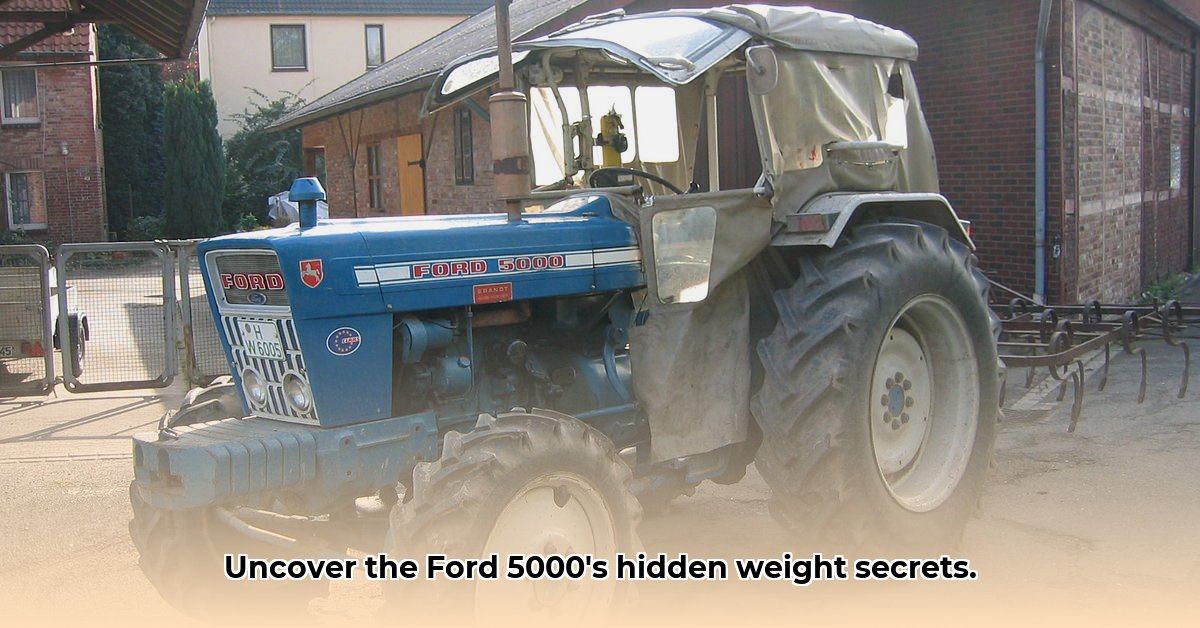
The Ford 5000 tractor—a name synonymous with agricultural prowess—holds a significant place in farming history. Understanding its weight, however, is more than just a simple numerical exercise; it's key to appreciating its capabilities, operational considerations, and even its value for collectors. This article delves into the Ford 5000's weight specifications, explores its rich history, and provides practical guidance for owners, enthusiasts, and restoration experts. For more on Ford compact tractors, see this helpful resource: Ford Compact Tractors.
Ford 5000 Tractor Weight: Specifications and Variations
Determining the precise weight of a Ford 5000 isn't straightforward. The weight varied considerably based on several factors, including model (row-crop vs. general purpose), engine type (gasoline or diesel), and attached implements. Sources often provide slightly different figures due to variations in testing methodologies and equipment configurations.
Generally, the base weight of a Ford 5000 falls within a range of 4,500 to 6,500 pounds. However, adding a front-end loader or other implements can easily add another 1,000 to 2,000 pounds. This weight variation significantly impacts ground pressure, traction, and fuel efficiency. A heavier tractor generally offers better traction but can increase soil compaction. Understanding this nuanced relationship is critical for optimal operation.
Isn't it fascinating how much a simple addition like a front-end loader can drastically change the overall weight and operational characteristics of the tractor?
Historical Context: The Ford 5000's Legacy in Agriculture
The Ford 5000 was produced from 1965 to 1976. During that period, it solidified its position as a versatile and reliable workhorse, used widely across North America and beyond. Its powerful 4.2-liter engine, available in gasoline and diesel variants, provided ample power for diverse agricultural tasks. Farmers further benefited from the choice between 8-, 10-, and 16-speed transmissions, allowing for precise control and adaptability across varying field conditions. The tractor’s simple, yet strong construction, ensured reliability and ease of maintenance in comparison to more modern, technologically complex equivalents. The Ford 5000, therefore, stands as a testament to robust engineering and its enduring impact on farming practices.
Did you know that the Ford 5000's robust design made maintenance and repairs relatively simple, unlike many of today's more electronically complex tractors? This simplicity helped contribute to its enduring popularity.
Technical Specifications: Power, Performance, and Design
Beyond its weight, several key technical specifications define the Ford 5000’s capabilities. The tractor boasted approximately 69 horsepower at the drawbar and around 60 horsepower at the PTO (Power Take-Off), effectively handling demanding tasks. Its sturdy construction and various transmission options ensured adaptability to a range of applications. Understanding these specs offers a deeper appreciation for the machine's capabilities and limitations. The design elements, including the engine, transmission, and PTO specifications, are crucial for potential restoration or repair projects and are important to consider if you are engaging in restoration.
The Ford 5000's approximately 60 PTO horsepower makes it suitable for a wide range of power-driven implements. How does this horsepower compare to modern tractors in similar weight classes and what are the performance implications?
Operational Considerations: Maintenance and Fuel Efficiency
Maintaining a Ford 5000 requires regular attention and preventative maintenance. Regular oil changes, filter replacements, and fluid level checks are crucial for optimal performance and longevity. While not known for exceptional fuel efficiency by today's standards, proper operation and maintenance can help maximize fuel economy. Parts availability varies depending on the component, with some parts being more readily accessible than others. Collectors may need to rely on specialized suppliers or vintage parts dealers for certain components. Proactive maintenance, including timely oil changes and filter replacements, can significantly improve fuel efficiency and extend the tractor's lifespan. What are some common maintenance oversights and their potential consequences for a vintage Ford 5000?
Restoration and Preservation: A Collector's Guide
Restoring a Ford 5000 is a rewarding yet challenging endeavor for collectors and enthusiasts. Finding original or high-quality reproduction parts is often a significant undertaking. Thorough documentation throughout the restoration process helps ensure historical accuracy and enables effective troubleshooting. Online forums and specialized parts suppliers serve as invaluable resources in navigating the restoration journey. Careful attention to detail is essential in preserving both the machine's mechanics and its historical significance.
"The restoration of a Ford 5000 is a journey that blends mechanical skill with historical preservation," notes John Miller, a renowned vintage tractor restoration expert at the National Agricultural Machinery Museum. "Finding original parts can be challenging, but the reward of bringing a piece of history back to life is immeasurable.”
Conclusion: The Enduring Appeal of the Ford 5000
The Ford 5000 tractor stands as a testament to durable design and agricultural innovation. Its versatile capabilities, coupled with its historical significance, continue to attract farmers, collectors, and enthusiasts alike. Understanding its weight, specifications, and operational characteristics allows for not only its proper operation but also its preservation for future generations. The Ford 5000’s legacy isn’t just about its role in history—it’s a symbol of a time when reliability and simplicity were paramount in agricultural machinery.
What are your thoughts on the lasting impact of the Ford 5000 on agricultural technology and its enduring appeal to collectors?